Learn to make Kanji recipe – a traditional North Indian fermented drink. This healthy probiotic drink is traditionally made with black carrots. But with all the health benefits, my easy recipe is made with juicy red carrots and beets.
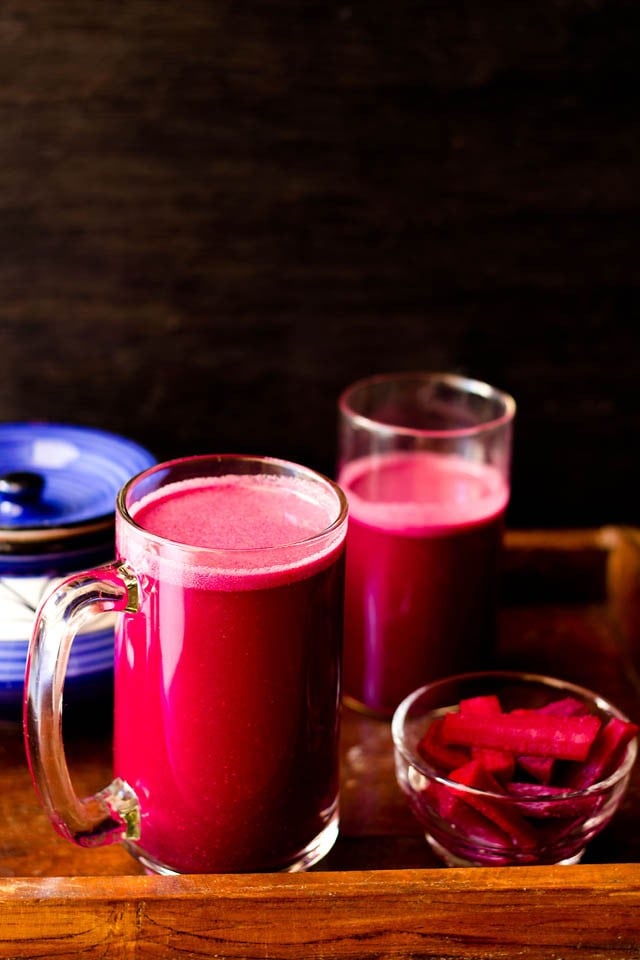
What is Kanji
Kanji is a probiotic drink made in the Northern Indian states. You can compare it with Kombucha, but the process of making kanji is entirely different than Kombucha.
Being a probiotic drink it is extremely good for the gut and improves digestion. Traditionally Kanji recipe is made with black carrots and this drink has a dark purple color. I do not get black carrots and I make this healthy drink with red carrots.
Kanji is spiced with ground mustard seeds, red chilli powder and black salt or salt. The carrots, spices, seasonings are mixed with some boiled cooled water and kept to ferment for a few days.
The entire drink with its ingredients is filled in a glass or ceramic jar. These jars are kept in the sunlight and the drink is allowed to ferment for 2 to 3 to 4 days.
It depends on how the sun is behaving in your region. So the drink can be kept for 4 to 5 days if the sunlight is not enough. If it is hot or very hot, then 1 to 2 to 3 days are enough for the drink to get naturally fermented.
The mustard in the kanji drink keeps the body warm during the cold winters of North India. The fermentation process changes the flavors of the drink and makes it probiotic. The taste is mild sweet and sour with that unique aroma of a fermented drink.
Kanji is served as an appetizer drink. It has a sour, spicy and pungent taste. This taste is an acquired one – either you will like or won’t like it, just like Kombucha.
About This Recipe
With all of you, I share my family recipe to make this healthy drink. I have learnt this method of making Kanji from my mother-in-law.
She makes this drink every year with black carrots, while I use a mix of carrots and beets to get that dark reddish-purple color – as black carrots are difficult to get where I live.
You could also make a few variations to your kanji recipe by including some turnips or peeled watermelon rinds.
While I do make kombucha almost all year around, I make kanji only during the winters. In the Indian winters, I get access to fresh tender juicy red carrots, which is not the case through out the whole year.
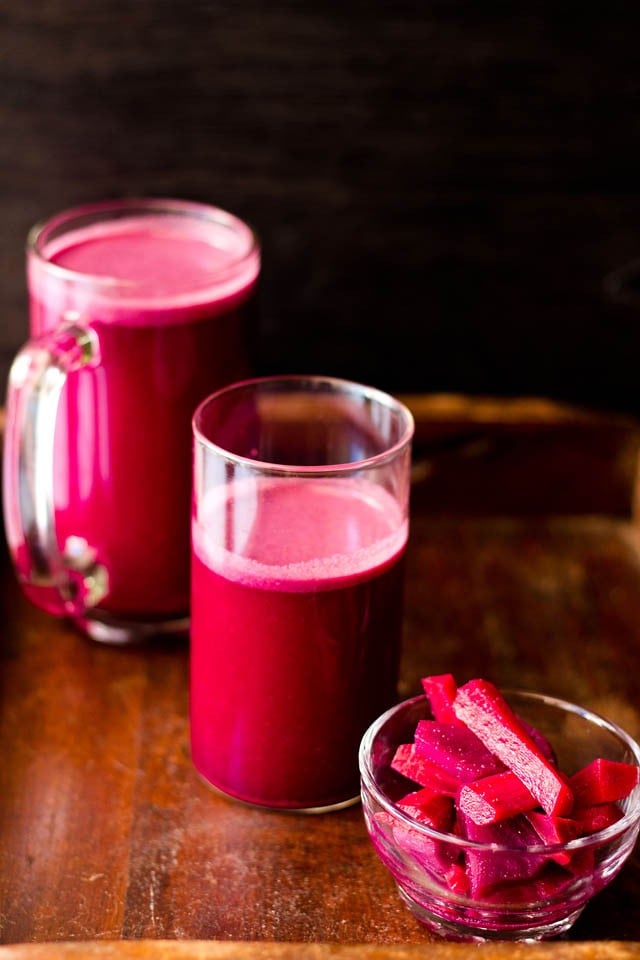
The carrots and beets get pickled during the process of fermentation. They have a lovely fermented, pickled flavor and taste. So can be served as a side condiment with any Indian main course or added to salads, wraps, burgers.
I also prepare urad dal vada (black gram fritters) to soak in the kanji. This is a variation of the popular Kanji Vada that I make.
The method of making the vada for Dahi Vada is the same as that for Kanji vada. I have given details of the vada recipe in the notes section of the recipe card below, if you would like to make them.
The soft vada soaked in the sour kanji drink tastes so good. If you like dahi vada, probably you will kanji vada as well.
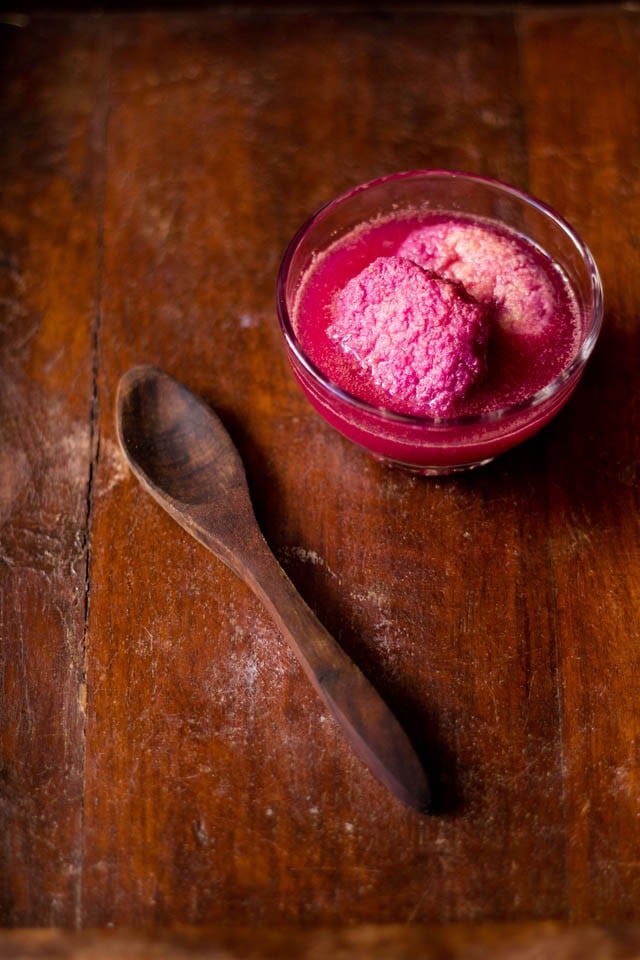
Step-by-Step Kanji Recipe
Prep The Ingredients
1: Rinse, peel and chop the carrot into batons or sticks with 1.5 to 2 inches length as shown in the photo below. Peel and chop the beets into 1.5 to 2 inches wedges or sticks.
Note that you can use orange carrots, if you do not have red carrots. If you are not a fan or beets, skip them and swap with 1 more medium-sized carrot.
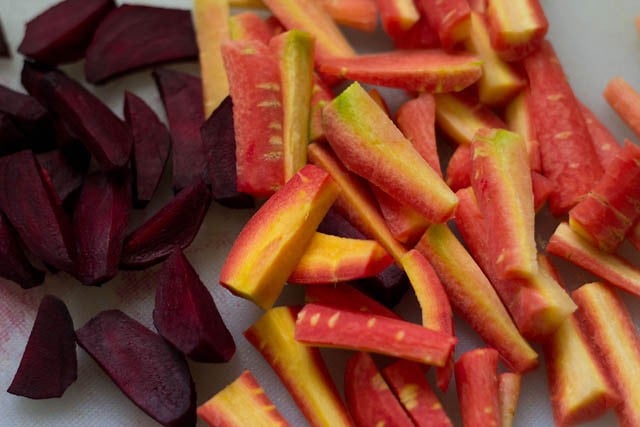
2: In a dry grinder, grind the 2 tablespoons yellow mustard to a fine powder. If including black or brown mustard, use 1 tablespoon.
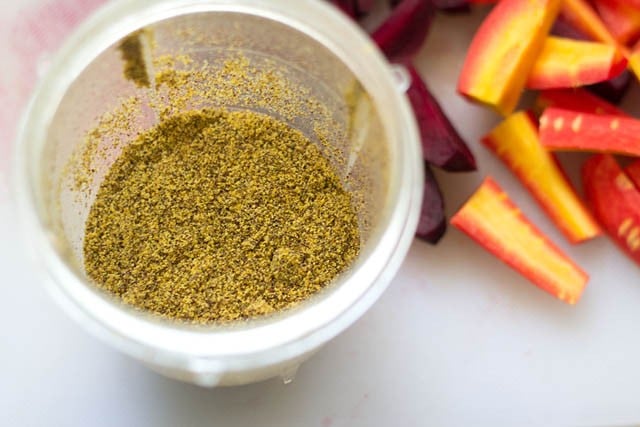
Mix the Kanji Ingredients
3: Boil water first. Let it cool at room temperature. In clean and dry ceramic or glass jar with a wide mouth, add the carrots, beets, ground yellow mustard powder, black salt or regular salt and red chili powder.
Pour this boiled cooled water in the jars. If you prefer, you can filter the water using a fine mesh strainer while pouring it in the jar.
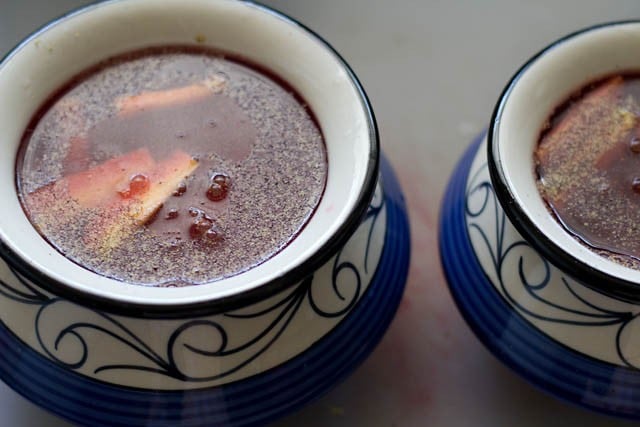
4: Stir this mixture well with a clean dry spoon.
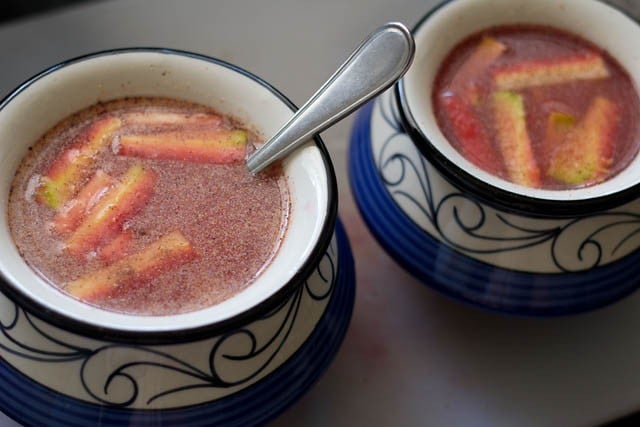
Ferment
5: Cover loosely with a lid or secure and tie a muslin/cheese cloth on the mouth of the jars or bottles. Keep the jars or bottles in sunlight.
Allow to ferment for 2 to 3 days until the drink becomes sour. Take care not to over ferment the drink.
Stir the mixture every next day with a clean wooden spoon before placing in the sun. Alternatively shake the jar instead of mixing with the spoon.
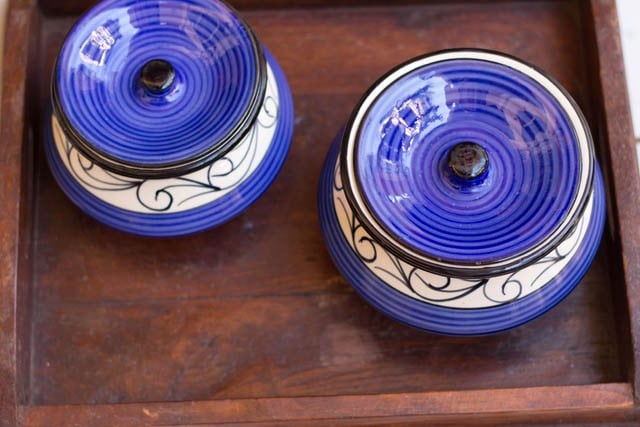
Serving & Storage Suggestions
6: When the drink starts tasting sour, it means the carrot kanji is ready. Keep the kanji drink in the refrigerator or serve straightway.
You could add a few ice cubes while serving. I like to have cold kanji, so I refrigerate it for a few hours. Kanji keeps well in the fridge for 4 to 5 days.
Drink the kanji before meals or anytime during the day. Serve the fermented carrot and beets sticks as a pickle with any Indian main course.
The sour-tangy carrots and beets can be included in a Salads or as toppings to your wraps, burgers or sandwiches.
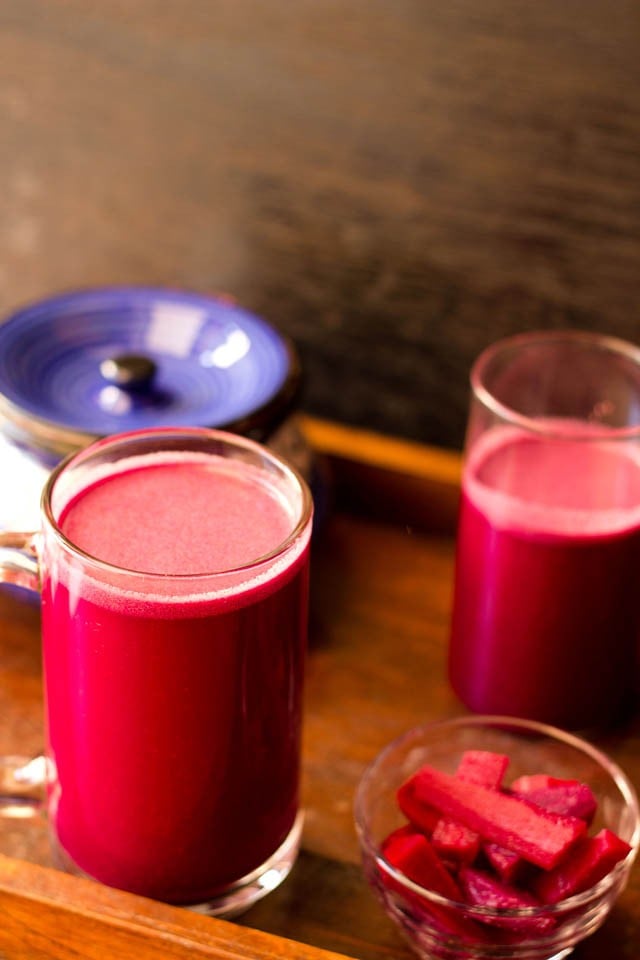
Expert Tips
- Cleanliness: Any fermented drink need care so that you do not end up with bad microbes in it. Ensure that your jars, spoons, chopping boards, knives are all clean and dry. If you see any layer of fungus, then throw away the drink. If the drink has an awful smell, that means it has gotten bad, so discard it.
- Mustard: You can choose to use both black or yellow mustard. However keep in mind that black mustard has a more pungent flavor, so add lesser amount of it – about 1 to 1.5 tablespoons. I have used yellow mustard which is milder.
- Boiling water: I highly recommend to boil water and cool it at room temperature. This way you rule out your kanji going bad. Tap water or even machine filtered water can spoil the drink.
- Variations: Together with carrots and beets, you can include turnips and peeled watermelon rinds in the drink. You do not need to add any sugar or sweetener in this drink as the natural sugar, starches in the carrots and beets help the friendly bacteria to feed on and ferment the drink naturally.
More Healthy Drinks To Try!
Beverages
Beverages
Beverages
If you’ve tried this recipe, please rate it in the recipe card or leave a comment below – I’d love to hear your feedback. For more vegetarian inspiration, sign up for my email updates or follow me on Instagram, Youtube, Facebook, Pinterest or X.
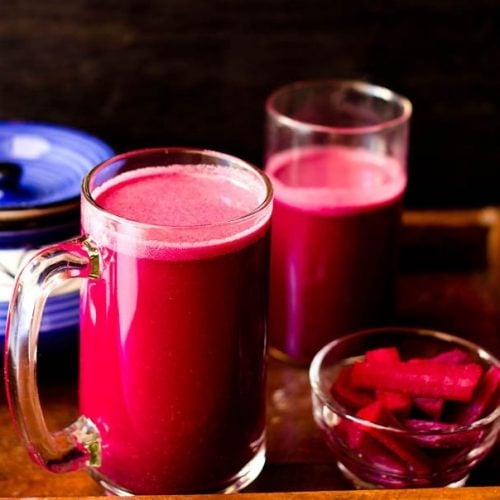
Kanji Recipe
Ingredients
- 5 to 6 carrots – medium-sized
- 2 beetroots – small-sized
- 8 cups water – approx 2 litres of water, boiled
- 2 teaspoons Red Chili Powder or cayenne pepper – add as needed
- 2 tablespoons yellow mustard seeds or 1 tablespoon black mustard seeds
- 1 tablespoon black salt or regular salt or pink salt, add as needed
Instructions
- Rinse and then peel the carrots and beetroots.
- Note that you can use orange carrots, if you do not have red carrots. If you are not a fan or beets, skip them and swap with 1 more medium-sized carrot.
- Chop into 1.5 to 2 inches long sticks or batons.
- First boil water and let it cool at room temperature. Cover the pan when the water cools.
- In a clean ceramic or glass jars with a wide mouth, add the carrots, beets, ground yellow mustard powder, black salt, pink salt or regular salt and red chili powder or cayenne.
- Mix all the ingredients with a clean dry spoon.
- Cover with loosely with a lid or secure and tie a muslin cloth/cheese cloth on the top of the jar or bottle. Keep the jars in the sun for 2 to 3 days or up-to 4 to 5 days depending on the sunlight in your area.
- For an intense and strong sunlight, about 1 to 2 days is good enough for fermentation. When there are cloudy days and less sunlight, 4 to 5 days will work. But do ensure that your kanji drink is fermented well. Do not keep so long that will make your drink over fermented.
- Stir with a wooden spoon or shake the jar everyday.
- When the kanji tastes sour, it means the drink is fermented.
- Serve carrot kanji straightway or refrigerate. It stays good in the fridge for about 4 to 5 days.
- You could add a few ice cubes while serving or refrigerate to make it cold before serving.
- Drink the kanji before meals or anytime during the day. Serve the fermented carrot and beets sticks as a pickle condiment with any Indian main course.
- The sour-tangy carrots and beets can be included in a salad or add as toppings to your wraps, burgers or sandwiches.
Notes
To make Kanji Vada
- Soak ½ cup urad dal(husked black gram) in water overnight or for 6 to 8 hours. Drain the extra water. Rinse the soaked lentils a few times draining all the water.
- In a blender or grinder, grind the urad dal with 1 green chili, ½ tsp cumin, a pinch of asafoetida, 1 inch ginger and salt with very less water to a thick flowing batter.
- Heat oil for deep frying in a pan or kadai (wok). Gently place spoonfuls of the the batter into medium hot oil. Fry the vada until they are golden and crisp. Drain on kitchen paper towels for a few minutes
- Then soak the fried vadas in water for 12-15 minutes. Gently press the soaked vada between the palms of your hands to squeeze out the extra water.
- Soak these vadas in the kanji for a few hours or overnight in the refrigerator. Serve kanji vada cold or chilled.
Nutrition Info (Approximate Values)
Kanji recipe from the blog archives was first published on March 2013. It has been updated on December 2024.
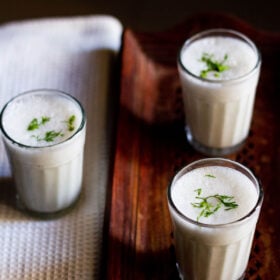
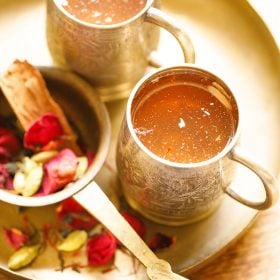
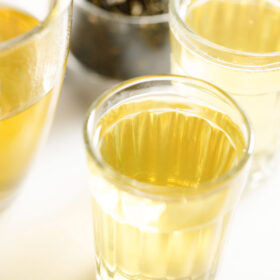
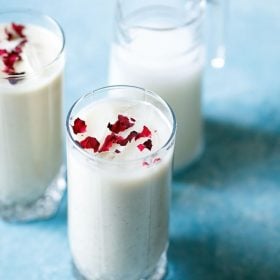
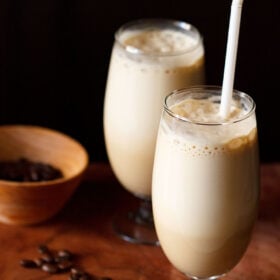
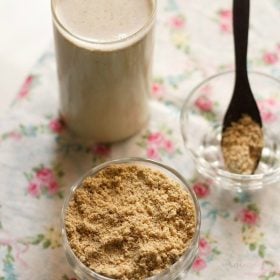
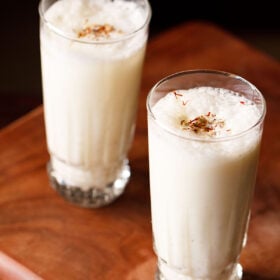
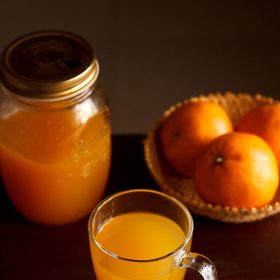








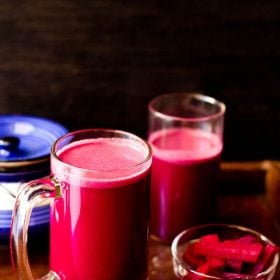
Great!
Description excellent.
Thank you.
Do I need to refrigerate the beets and carrots after the kanji is made?
The kanji has to be refrigerated after it is properly fermented. At room temperature it will start over-fermenting, specially in warmer or hotter climates. If the drink is finished and only the fermented carrots and beets remain, keep them in the refrigerator.
there is some white layer forming on the top within a day ,should i leave it or remove & let it stay in the sun for some more days?
The top white layer could be a mould growth. Please do not consume. Unfortunately the kanji cannot be saved and you will have to trash it.
Very nicely narrated by you. We made it and tasted good. Very nice.
Thank you.
Delicious! I have made this every week this winter season.
Excellent and thorough. Dassana Amit, You are Awesome!!!
Thank you so much.
Very nice.
Thankyou for a detailed explanation of making storing and having. Very helpful.
Hello, I live in Canada and we don’t have sunlight for days plus it’s freezing temperature outside. What do we do in that case?
I am afraid, sunlight is needed.
I live in Canada too, I made it and kept it on counter where you get brightest light, by end of third day, it was fermented and had a nice tangy taste. I had used another recipe, very similar though. This time i am trying this recipe.
Nice and simple. With detailed precautions to take for a good result.
I prepared this recipe and it turned out to be very good. Thank you for sharing.
Nice to know and thanks for sharing your feedback. Thanks for the rating too.
Awesome